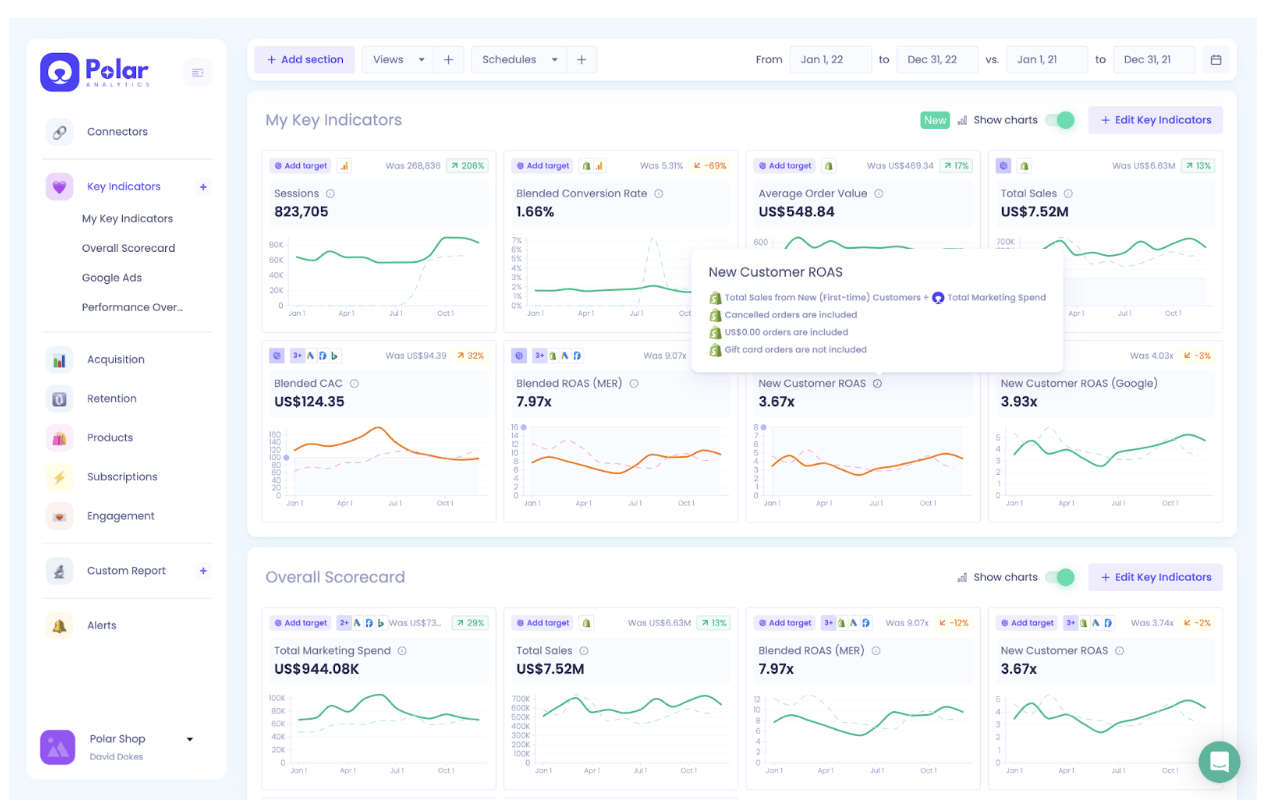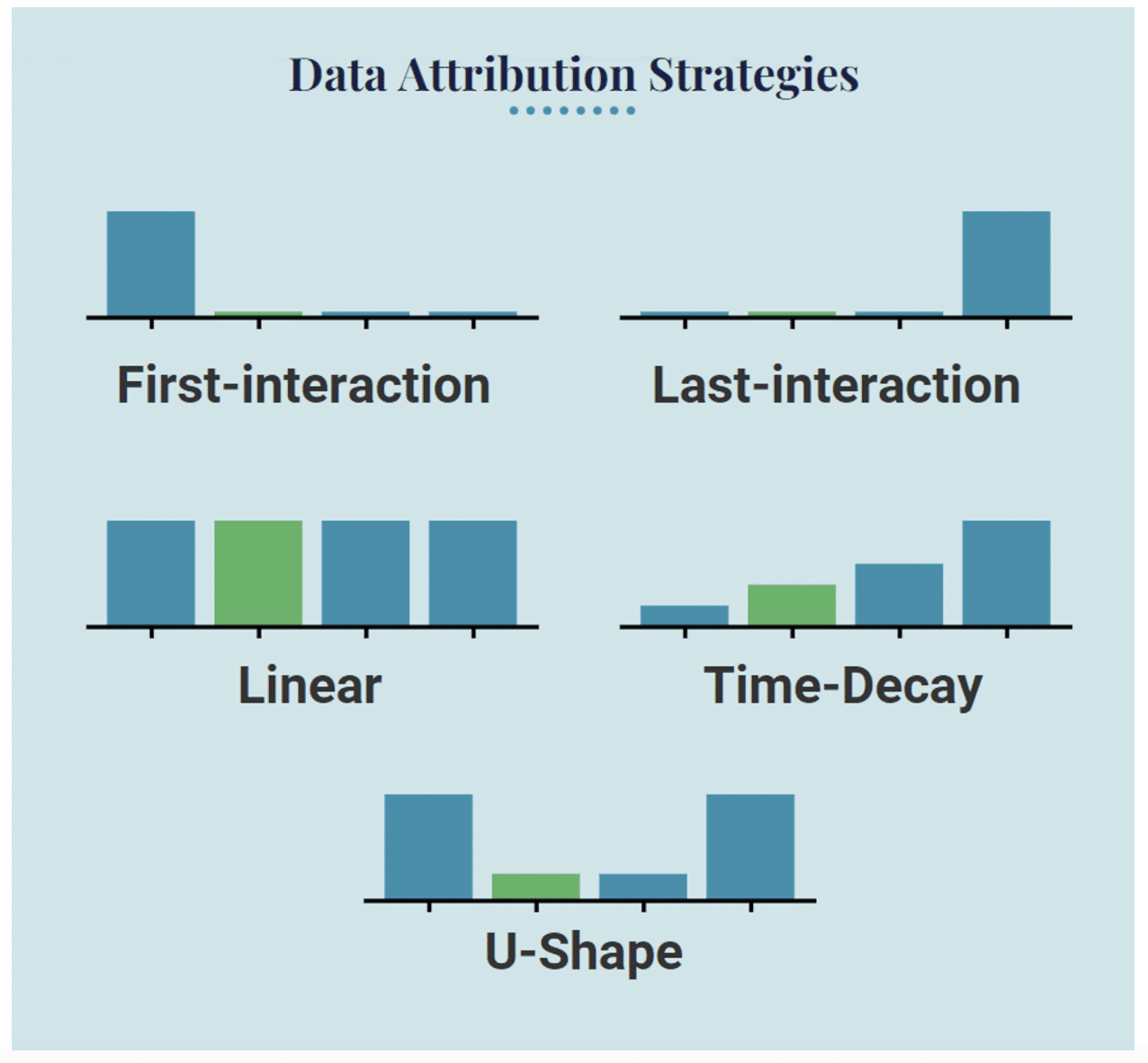Complete Guide To Shopify Data Attribution
What good is data if you don’t know where it came from? Without proper attribution, numbers are just noise.
The trouble with data attribution is that it’s getting harder to come by these days. Google plans to phase out third-party cookie trackers by the end of 2023. This makes it more challenging to tell where your customer data comes from.
The same is true for Apple, which has already done much of the work of blocking third-party cookies.
As a result, businesses have to do some fending on their own. Not only do they have to capture more of their own data, but they have to learn how to attribute it.
For context, data attribution is how you assign credit for customer conversions. When did an Internet user become a customer? Was it when they read an email newsletter? Found you on social media? Downloaded a webinar?
As it turns out, 75% of companies use a multi-touch attribution model to track the performance of their marketing. If you don’t know how to even attribute the data you have coming in, you’re at a major disadvantage vs. your competitors.
In this guide to data attribution and its uses and benefits, we’ll explore:
– The Benefits of Data Attribution
– The Challenges to Effective, Personalized Data Attribution
– How to Improve Data Attribution
In each section, we’ll tackle the specifics of the category to get a clearer look at why—and how—you can use data attribution to improve the personalization and performance of your marketing.
The Benefits of Data Attribution
Is the work you do to enhance data attribution worth it? Let’s explore a few key benefits of improving how you attribute your conversions:
Improving Where You Spend Your Marketing Dollars
Ideally, data attribution answers a simple question: where should you put your marketing dollars?
Once you can tie a specific purchase to a specific marketing campaign, you’ll know what’s really driving the conversions. From there, you can double down on what works and move money away from what’s not.
And that’s great. For example, let’s say 50% of your sales came from social media and 25% came from an SMS marketing list.
Assuming equal amounts of traffic went to both campaigns, the data’s clear. Social media is working twice as well as your SMS campaign.
Statistics suggest 41% of marketers use the “last touch” method for online attribution. This is a popular method because it connects the most recent action a customer took with their decision to buy.
But you can go even deeper than “last touch” attribution by studying other things like “first-touch” attribution, for example. This is how customers discovered your brand (so you can lean into that and acquire even more customers.)
The bottom line: don’t stick to the popular data analysis methods; go deeper.
Enhancing Personalization for More Sales
Knowledge is power. But if you don’t put knowledge into action, you won’t benefit from that power.
Fortunately, data attribution makes it easier to incorporate sales optimization strategies.
If you’re keeping track of multiple touchpoints, you’ll have an idea of which touchpoints converts customers most often. What are the most compelling customer journeys?
For instance, let’s say you find that customers who download a webinar and then visit your signup form convert at 10%. But those who download a webinar, visit a signup form, then view a video convert at 15%.
Suddenly you’ve got a potential modification for your touchpoint: adding that video to your signup form, or possibly raising it “above the fold.”
Data attributed to multiple touchpoints makes this 360-degree customer view possible.
Rather than judging offline events, social posts, blogs, videos, or in-store visits by how well they convert by themselves, you can view how they also convert in combination.
To optimize your personalization strategy, look at which touchpoints worked best. When was the timing just right? You can use this information to inform customer journey maps in the future.
Improving Customer Segmentation
There’s an old saying: if you’re selling to everyone, you’re selling to no one.
In the world of customer segmentation, it’s true. The broader your user segments are, the worse your personalization will be. It won’t help your customer experience, either.
On the other hand, highly-specific customer segments help you highlight key benefits to customers. They can then say: “this is exactly what I was looking for.”
The worst part? You can never see the conversions you leave on the table when you leave customer segmentation out of your marketing efforts.
Those non-conversions are invisible. You’ll be left wondering if something else is at fault.
To optimize your customer conversions, add specificity to your customer segments. Break them out into the various stages of your customer journey. Examples include customer segments which divide into phases like awareness, research, or decision.
Once you know which customers are in which stage of your customer journey, you can form your messaging to cater to that.
For example, you wouldn’t unleash “Meet Our Service”-style brochures with customers who are near the point of decision. That would seem so hopelessly out of place that the customer might rethink your capabilities before buying.
Increasing Return on Ad Spend (ROAS)
The whole point of becoming more efficient with conversions is money. But it’s not just about landing more conversions. It’s also about identifying where to put the money that might result in the highest likelihood of creating those conversions.
Return on Ad Spend (ROAS) is what matters here. Omnichannel data will give you a fuller picture of which touchpoints had the biggest impact on your marketing success.
Studying multiple touchpoints can help you discover what messaging resonates most. You can then double down on those strategies with some degree of confidence that you’ll get higher ROAS.
But that’s not all you can do with multiple touchpoints. You can also lift the most impactful messaging for other areas of your customer journey, such as:
- CTA: Use calls to action that address the most relevant pain points, or use verbiage that resonates with your audience in other touchpoints
- Positioning: What key benefit should you highlight “above the fold” on landing pages? Multiple touchpoints can help you find the answer to the benefits customers love the most
- Additional content: You can use these insights to inform the rest of your content as well. Is the appropriate product showing up for the right customers, for example?
The Challenges to Effective, Personalized Data Attribution
It all sounds great, but steep challenges to proper data attribution can stand in the way. Here are some of the key challenges—and how companies are overcoming them.
The Technology to Enable Better Attribution
One challenge: technology. Or, more accurately, the lack thereof. Data attribution isn’t easy, after all. It requires more than slapping a tag on a specific conversion.
That might be accurate, but it’s also manual and labor-intensive. And automated services might solve that problem, but you still have to wonder about their accuracy.
One solution is to use technology that can handle multiple touchpoints with its data. As we previously noted, “If you want to test new variations of several pages in the same flow at once you are better off using multi-page testing. Just ensure you get attribution right.”
You can also consider what kind of existing solutions might help you improve your data attribution. There are tools like Active Campaign for Marketing and SharpSpring, but other tools are making headway in this space, with Polar Analytics being one of note.

Polar Analytics uses 17+ eCommerce-specific data connectors to bring in data from across the spectrum of your marketing campaigns. From there, you can get a true first-party attribution model with server-side tracking (and it works with iOS 14 – no need for cookies) to identify poor-performing campaigns, scale high-performing ones, and train the algorithms to generate more sales for your business.
This is a low-code solution connecting to all sorts of ecommerce tools—analytics, advertising, email campaigns, etc.—which helps remove the guesswork from trying to find the perfect “tech stack” to make your data attribution possible.
Getting Your Marketing / Other Teams on Board
Technology is your foundation for proper data attribution. Without it, you won’t get far. But a tech stack won’t help your organization until you get your marketing—and any other team involved in your data—fully on board.
But what does it mean to be “on board” with data attribution?
For starters, you need synergy. Your marketing, data, and sales teams should be in agreement that your data attribution strategy is going to help everyone succeed.
On paper, this sounds easy. Who wouldn’t be in favor of better data and analytics? Who wouldn’t want to make more sales?
But keep in mind that any change can be a catalyst for concern. The Harvard Business Review, for example, reviewed 77 specific instances of organizational-level change. They discovered that no matter the change happening, the most common reaction was concern. In some cases, it was outright shock.
Tell people you’re throwing the old data strategy out the window, and you can expect to run into the following questions:
- “Wait, I was in charge of a lot of that. Are you telling me I did a bad job?”
- “That’s not my department. Am I going to have to learn something new? That’s not what I signed up for.”
- “The old way works fine—why are we fixing something that ain’t broken?”
The list goes on and on. Everyone will find a way to resist change. Your job, if you’re going to implement proper data attribution, is to nip these concerns in the bud.
- Watch how you frame the data attribution. Don’t storm into a meeting and declare: “The old way of doing things is dead.” Of course, that’s going to rub people the wrong way. But if you frame the new strategy as part of a new campaign, or even a new A/B test, people will understand why you’re implementing new data attribution strategies.
- Ask for input. No one likes to be told “my way or the highway.” If they’re going to implement your strategies, it helps if they adopt them as their strategies. Before you launch anything, ask the team for help implementing these new strategies—and incorporate that feedback into your approach.
It might not always be smooth sailing at first. But you shouldn’t expect it to go 100% perfect the first time. Experience, over time, will teach you the tweaks you need.
How to Improve Data Attribution
Yes, even new data attribution systems require improvement. But that improvement will be some of the most important work you can do in marketing.
56% of marketers believe attribution is important. And if that sounds low, don’t forget that an additional 33% call it nothing short of critical.
The work to implement new data attribution and improve its accuracy over time will be worth it. But it’s not enough to schedule 15 minutes a day and block it off as “data attribution improvement time.” You’ll need some specific steps along the way.
Choose a Data Attribution Model
For starters, you have to make the big decisions—or else your attribution won’t make any sense to you. Here are some of the most popular models marketers will use:
- First-interaction attribution. This is when you tag a purchase according to the first encounter your customer had with your brand. This helps you understand what campaigns are best at attracting attention, but it can also be a little difficult to tell what convinced a customer to buy.
- Last-interaction attribution. A little closer to the final purchase is the final interaction that drew your customer to make a purchase. This helps you identify bottom-of-funnel key moments. Was it a landing page that convinced your audience? Was it the last in a sequence of emails you sent out? Although this is a very common way to identify what’s driving revenue, it also leaves out the ever-important customer journey.
- Multi-interaction attribution. To resolve the problems of both first and last interaction attributions, you can try implementing both. This will give you a complete picture of your marketing data, true. But it also makes reading that data more complicated.
- Linear attributions. One simple way to resolve the complications of multiple interactions? Assign equal weighting to each interaction. For example, if you had four interactions with a customer before they purchased, you might assign 25% of the conversion to each category. This is more accurate than awarding 100% to one attribution that might be wrong, sure. But you can get even more accurate if you know how to properly weigh each attribution.
- Time decay attributions. Let’s say you want to weigh your attributions towards the end of the customer journey until purchase. You can avoid linear attributions with time decay attribution, giving added weight the closer you get to the last attribution.
- U-shaped attributions. “U” shaped biases the attributions in favor of first and last attributions, but with some value left to assign attribution in touchpoints that took place in between. The resulting “U” curve shows you where you’re placing the highest priority for your conversions.

(Original image, created via Venngage)
On top of these models, some marketers even create their own algorithms. This means they can customize their data according to what they believe is the most important.
But you can’t do any of these attributions without one key investment.
Invest in the Right Software
Without data attribution software or CRM, it’s going to be difficult to get precise data. What made a customer decide to buy from you? One-touch attribution might hint at it.
But you don’t get an accurate picture of what’s driving conversions until you collect data from every touchpoint and assign it a weighted value.
Good software will also help you map out the complete buyer’s journey.
Don’t simply add touchpoints you think will matter. Observe customer journeys and the touchpoints that seem to create an impact. Include them in your customer journey map in the software you choose.
The result: you’ll have data with attribution that points in the right direction. You’re no longer Sherlock Holmes at the story’s beginning, looking for any clue you can find. You’re Sherlock Holmes at the end. You’ve figured out the mystery.
From there, you can use the data you have in your arsenal to change your marketing, double down on what’s working, and cut down on what isn’t.
Make Data Attribution Work for You
Data attribution might not sound as sexy as other marketing initiatives. But the results can be.
With proper attribution, you can build a customer journey map that fills you in: where are customers buying, and why? You can then use this to inform your marketing strategy at every level. From product positioning to brand messaging, good data attribution can synchronize your marketing efforts with your customer’s needs.
